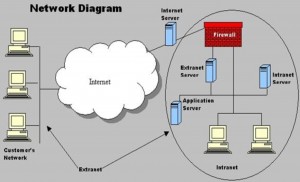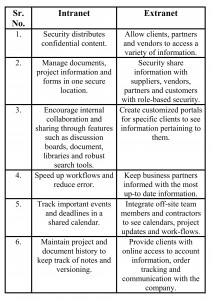Intranet and Extranets
Intranet
An intranet is a network based on TCP/IP protocols (an internet) belonging to an organization, usually a corporation, accessible only by the organization’s members, employees, or others with authorization. An intranet’s Web sites look and act just like any other Web sites, but the firewall surrounding an intranet fends off unauthorized access.
Benefits
1. Workforce productivity
Intranets can help users to locate and view information faster and use applications relevant to their roles and responsibilities. With the help of a web browser interface, users can access data held in any database the organization wants to make available, anytime and — subject to security provisions — from anywhere within the company workstations, increasing employees’ ability to perform their jobs faster, more accurately, and with confidence that they have the right information. It also helps to improve the services provided to the users.
2. Time
Intranet allows organizations to distribute information to employees as-needed by the employees.Employees may link to relevant information at their convenience, rather than being distracted indiscriminately by email.
3. Communication
Intranets can serve as powerful tools for communication within an organization, vertically strategic initiatives that have a global reach throughout the organization. The type of information that can easily be conveyed is the purpose of the initiative and what the initiative is aiming to achieve, who is driving the initiative, results achieved to date, and who to speak to for more information. By providing this information on the intranet, staff have the opportunity to keep up-to-date with the strategic focus of the organization. Some examples of communication would be chat, email, and/or blogs. A great real world example of where an intranet helped a company communicate is when Nestle had a number of food processing plants in Scandinavia. Their central support system had to deal with a number of queries every day.When Nestle decided to invest in an intranet, they quickly realized the savings. McGovern says the savings from the reduction in query calls was substantially greater than the investment in the intranet.
4. Web publishing
Web publishing allows cumbersome corporate knowledge to be maintained and easily accessed throughout the company using hypermedia and Web technologies.Examples include: employee manuals, benefits documents, company policies, business standards, news feeds, and even training, can be accessed using common Internet standards (Acrobat files, Flash files, CGI applications). Because each business unit can update the online copy of a document, the most recent version is usually available to employees using the intranet.
5. Business operations and management
Intranets are also being used as a platform for developing and deploying applications to support business operations and decisions across the internetworked enterprise.
6. Cost-effective
Users can view information and data via web-browser rather than maintaining physical documents such as procedure manuals, internal phone list and requisition forms. This can potentially save the business money on printing, duplicating documents, and the environment as well as document maintenance overhead.
7. Enhance collaboration
Information is easily accessible by all authorised users, which enables teamwork.
8. Cross-platform capability
Standards-compliant web browsers are available for Windows, Mac, and UNIX.
9. Built for one audience
Many companies dictate computer specifications which, in turn, may allow Intranet developers to write applications that only have to work on one browser (no cross-browser compatibility issues). Being able to specifically address your “viewer” is a great advantage. Since Intranets are user-specific (requiring database/network authentication prior to access), you know exactly who you are interfacing with and can personalize your Intranet based on role (job title, department) or individual (“Congratulations Jane, on your 3rd year with our company!”).
10. Promote common corporate culture
Every user has the ability to view the same information within the Intranet.
11. Immediate updates
When dealing with the public in any capacity, laws, specifications, and parameters can change. Intranets make it possible to provide your audience with “live” changes so they are kept up-to-date, which can limit a company’s liability.
12. Supports a distributed computing architecture
The intranet can also be linked to a company’s management information system, for example a time keeping system.
Extranet
An Extranet is actually an Intranet that is partially accessible to authorised outsiders. The actual server (the computer that serves up the web pages) will reside behind a firewall. The firewall helps to control access between the Intranet and Internet permitting access to the Intranet only to people who are suitably authorised. The level of access can be set to different levels for individuals or groups of outside users. The access can be based on a username and password or an IP address (a unique set of numbers such as 209.33.27.100 that defines the computer that the user is on).
The Benefits of Implementing an Extranet
1. Exchange large volumes of data using Electronic Data Interchange (EDI)
2. Share product catalogs exclusively with trade partners
3. Collaborate with other companies on joint development efforts
4. Jointly develop and use training programs with other companies
5. Provide or access services provided by one company to a group of other companies, such as an online banking application managed by one company on behalf of affiliated banks.
Difference between Intranet and Extranet




helpful